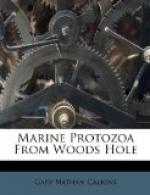Fresh and salt water, common in infusions.
Colpidium colpoda Ehr., sp. Fig. 38.
Synonyms: Colpidium cucullus Kent ’81; C. striatus Stokes ’85; Kolpoda cucullus Duj. ’41; Paramoecium colpoda Ehr. ’38, Quennerstedt ’67; Plagyiopyla nasula Kent ’81, G. & R. ’86; Glaucoma pyriformis G. & R. ’86; Tillina campyla Stokes ’85, ’88.
The body is oval, somewhat larger posteriorly, and a little compressed dorso-ventrally. The anterior end is twisted a little from the right to the left (more evident in fresh-water forms), and leans somewhat toward the ventral side. Under this portion, on the ventral side, lies the mouth in a large depression just above the middle of the body. The entire body is covered with uniform and delicate cilia, which are placed in longitudinal rows. These rows are almost straight on the dorsal side, but bend on the ventral surface, following the contour of the twisted anterior portion. The endoplasm is finely granular; the oesophagus leading into it is very distinct. Schewiakoff (’89) describes two membranes, an inner and an outer; Maupas (’83) describes them as right and left. In the present species I was able to make out only one. The macronucleus is central, spherical in form, and bears a single minute micronucleus. The contractile vacuole is posterior and dorsal to the long axis of the body. The anus is ventral to this axis and also posterior. Length 45 mu, width 20 mu. Common.
This marine variety is much smaller than the fresh-water form and the form differs in a number of respects, viz, in the anterior torsion and in the structure of the mouth. These may be, however, only individual variations of a widely spread species, and I believe it is perfectly safe to describe this as Colpidium colpoda.
[Illustration: Fig. 38.—Colpidium colpoda.]
Genus URONEMA Duj. ’41.
(Quennerstedt ’69; Cohn ’66; Kent ’81;
Buetschli ’81; Schewiakoff ’89;
Shevyakov ’96.)
Minute forms; colorless and constant in body form. The form is oval, slightly compressed on the ventral side, while the dorsal side is distinctly arched. The membrane is distinctly marked by rather widely separated striae. These occasionally have a spiral course about the body; in all cases they can be easily counted. The mouth is large and placed near the center of the ventral surface. It is sometimes approached by a very shallow depression or peristome from the anterior end, and marked by two rows of cilia. An undulating membrane extends down the mouth. Oesophagus absent. A long, stiff bristle extends outwards from the posterior end. The contractile vacuole is terminal or subterminal and near the anal opening. The macronucleus is spherical, centrally placed, and with one micronucleus closely applied. Movement is rapid and usual forwards in a straight line, often found resting, however, with outstretched cilia in contact with some foreign body. Food mainly bacteria. Fresh and saltwater, usually in decomposing vegetable substances.




